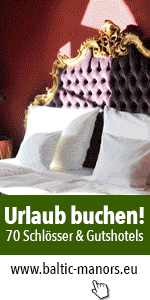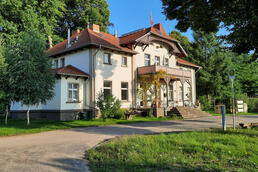Manor House Kleinmenow - VILLA METEOR
Nowadays the village of Kleinmenow is located in Brandenburg; however, its history is closely linked to that of Mecklenburg due to its direct location on the latter's border.
In January 1862, a meteorite the size of a bucket struck Kleinmenow, parts of which can now be seen in museums around the world and which gave the villa its current name "METEOR".
Menow was first mentioned in a document in 1418. The Klein Menow farm became an independent dairy farm in 1765 and was raised to a hereditary leasehold farm in 1810.
The tenant's dwelling house, built around 1900, is in many details indebted to the late historicism as well as the 'Heimatstil' (regional-traditional style). The publications on agricultural architecture, which were published in large numbers at the time, unmistakably had an influence on the planning.
In front of the house, an old lime tree stands asymmetrically on the roundabout. The paved driveway was bordered with hedges and had an archway at what is now the street corner.
To the east a landscaped park adjoins in which there was a tea pavilion and most of whose old trees are still preserved.
The farm buildings consisting of a stable, a barn, a greenhouse, a smithy, and a pump house, which were grouped around a rectangular courtyard towards the lake in the west, are unfortunately not preserved. On the meadow in the line of sight to Lake Ziernsee was a windmill that pumped water into the reservoir in the attic of the dwelling house, which still existed until 2018.
The house was adorned by a wooden balcony that rested on a densely-covered veranda. In the 1930s it was replaced by a spacious terrace sitting on brick columns and decorated with sculptures.
At the beginning of the 1920s, General Paul Fleck, already retired, was the owner of the estate. In the course of the land reform, the later owner Bernhard Kirchner was expropriated by the Soviet army in 1945.
In GDR times, the façade decoration was removed and the building was divided into six rented flats. Since then, the Stölke and Kruggel families have lived in the house, which was called the "fairytale castle" during this time. Due to lack of maintenance, the terrace was demolished in 1998. In 2012, the Kommunale Fürstenberger Wohnbaugesellschaft (Fürstenberg Municipal Housing Company) sold the building to the Berlin architect and urban planner Tim Lehmann, who has since gradually renovated the building and rebuilt the balcony as a wooden construction based on the original. Nowadays the house is jointly inhabited by six long-established Fürstenbergers and used as a weekend residence by 14 Berliners.
A small memorial stone at the eastern tip of the estate commemorates the impact of the meteorite and the shepherd who got away with his flock of sheep with a fright.
Thanks for editorial support to Tim Lehmann


